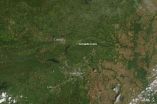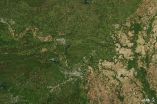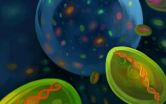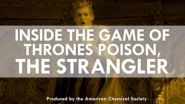(Press-News.org) A violent tornado touched down in Arkansas on April 27, 2014, killing as many as 15 people. The top image, acquired on April 28 by the Moderate Resolution Imaging Spectroradiometer (MODIS) on NASA's Aqua satellite, shows what appears to be a tornado track north of Little Rock, Arkansas. The lower image, from April 25, shows the same area before the storm. The tracks are pale brown trails where trees and plants have been uprooted, leaving disturbed ground.
The difference in clarity between the two images is likely due to the centering of the scene beneath the satellite. On April 25, Aqua flew more directly over the area, while on April 27, it observed the Little Rock area from a slightly offset angle.
INFORMATION:
NASA satellite spots tornado track near Conway, Ark.
2014-04-29
ELSE PRESS RELEASES FROM THIS DATE:
Preliminary results show improvement in MS symptoms
2014-04-29
Combining the estrogen hormone estriol with Copaxone, a drug indicated for the treatment of patients with relapsing forms of multiple sclerosis (MS), may improve symptoms in patients with the disorder, according to preliminary results from a clinical study of 158 patients with relapsing remitting multiple sclerosis (RRMS). The findings were presented today by Rhonda Voskuhl, M.D., from the University of California, Los Angeles, at the American Academy of Neurology Annual Meeting in Philadelphia. The study was funded by the National Institute of Neurological Disorders and ...
Octillions of microbes in the seas: Ocean microbes show incredible genetic diversity
2014-04-29
The smallest, most abundant marine microbe, Prochlorococcus, is a photosynthetic bacterial species essential to the marine ecosystem.
It's estimated that billions of the single-celled creatures live in the oceans, forming the center of the marine food web.
They occupy a range of ecological niches based on temperature, light, water chemistry and interactions with other species.
But the diversity within this single species remains a puzzle.
To probe this question, scientists at the Massachusetts Institute of Technology (MIT) recently performed a cell-by-cell genomic ...
Consuming high-protein breakfasts helps women maintain glucose control, MU study finds
2014-04-29
COLUMBIA, Mo. – In healthy individuals, the amount of glucose, or sugar, in the blood increases after eating. When glucose increases, levels of insulin increase to carry the glucose to the rest of the body. Previous research has shown that extreme increases in glucose and insulin in the blood can lead to poor glucose control and increase an individual's risk of developing diabetes over time. Now, a University of Missouri researcher has found that when women consumed high-protein breakfasts, they maintained better glucose and insulin control than they did with lower-protein ...
New data suggest potassium & dietary fiber intake among toddlers should be priority
2014-04-29
(SAN DIEGO, CA) April 29, 2014 – Recommendations to increase the intake of potassium and dietary fiber among young children should be a priority for the 2020 Dietary Guidelines for Americans, according to a new study by the Alliance for Potato Research and Education (APRE) presented today at Experimental Biology 2014.
While the federal Dietary Guidelines has focused on adults and children 2 years of age and older, the 2020 Dietary Guidelines will include Americans of all ages, starting from birth, noted Maureen Storey, PhD, co-author of the study and APRE president and ...
Two-part special issue of Ergonomics in Design highlights climate change
2014-04-29
Human factors/ergonomics (HF/E) experts, like professionals in many other scientific domains, have joined the fight against global warming and climate change. Their research and practice focus on finding ways to combat or minimize its serious effects.
A special two-part issue of Ergonomics in Design examines how HF/E professionals can continue working to mitigate this worldwide phenomenon. Part 1 of the special issue, guest edited by Ken Nemire, is now available online and may be found at http://erg.sagepub.com/.
"With recent research indicating we stay close to ...
NRL researchers develop harder ceramic for armor windows
2014-04-29
The Department of Defense needs materials for armor windows that provide essential protection for both personnel and equipment while still having a high degree of transparency. To meet that need, scientists at the Naval Research Laboratory (NRL) have developed a method to fabricate nanocrystalline spinel that is 50% harder than the current spinel armor materials used in military vehicles. With the highest reported hardness for spinel, NRL's nanocrystalline spinel demonstrates that the hardness of transparent ceramics can be increased simply by reducing the grain size to ...
Saving crops and people with bug sensors
2014-04-29
RIVERSIDE, Calif. (http://www.ucr.edu) — University of California, Riverside researchers have created a method that can classify different species of insects with up to 99 percent accuracy, a development that could help farmers protect their crops from insect damage and limit the spread of insect-borne diseases, such as malaria and Dengue fever.
Over the past 60 years, insect classification research has been limited by factors including an overreliance on acoustic sensing devices, a heavy focus on wingbeat frequency and limited data.
The UC Riverside researchers overcame ...
The Strangler: The chemistry behind the Game of Thrones poison (video)
2014-04-29
WASHINGTON, April 28, 2014 — Game of Thrones gave us a shock with the Purple Wedding and now everyone is asking: "Who poisoned King Joffrey?" While the search for the killer continues, the American Chemical Society's latest Reactions video focuses on what killed the hated king. The video is available at http://youtu.be/6UNEpRXcxM4
Chemist Raychelle Burks, Ph.D., of Doane College helps us narrow down the suspects in her charismatic style, blending pop culture and chemistry. "Sometimes science gets a bad rap. People think it's dry or super serious," Burks says. "Pop culture ...
Information technology can simplify weight-loss efforts; social support still important for success
2014-04-29
COLUMBIA, Mo. – According to the Centers for Disease Control and Prevention (CDC), 69 percent of adults in the United States are currently overweight or obese, which puts these individuals at increased risk for chronic health problems. Although weight loss decreases this risk, statistics show that dieters often fail multiple times before meeting their goals. Now, MU researchers have found that information technology, such as smartphone applications, can help dieters integrate healthy behavior changes into their daily lives.
"Current weight loss recommendations are essentially ...
Immunogenic mutations in tumor genomes correlate with increased patient survival
2014-04-29
April 29, 2014 – Developing immunotherapies for cancer is challenging because of significant variability among tumors and diversity in human immune types. In a study published online today in Genome Research, researchers examined the largest collection of tumor samples to date to predict patient-specific tumor mutations that may activate the patient's immune system, paving the way for more successful, personalized cancer immunotherapy.
Tumor cells accrue mutations in their DNA, and as these mutations accumulate, the cell looks less and less like part of the body and more ...





